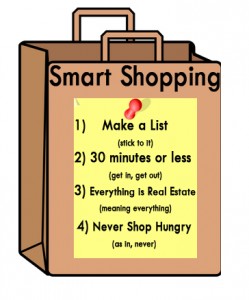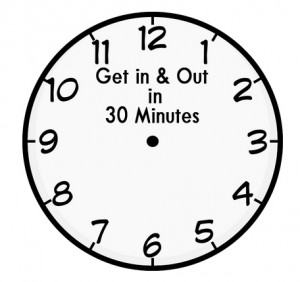Smart Shopping Tips
Gina Petracca is a first year graduate student at Boston University in Sargent College’s DPD/MS+DI program.

Let’s face it: grocery stores are overwhelming. There is an exorbitant amount of food and an endless number of options. Where do you even begin? And how are you supposed to make healthy decisions with so many treats taunting you at every turn? To start, here are some basic tips to help keep your shopping experience quick and healthy.
Navigate the perimeter. The majority of the food that you actually need is located on the perimeter of the store. Sure, you need to go down a few aisles to get things like canned goods, pasta, rice, bread, cereal, and coffee; but there is no need to snake through the aisles. The “snaking” method exposes you to tons of products that you do not actually need, but that look appealing/necessary. Foods that are in their “whole” or original state (ex: produce, meat) are on the perimeter and just so happen to require refrigeration. Foods that are processed are in the aisles. Stick to the perimeter instead.
 #1 Make a list and stick to it: we’ve all heard it before—make a shopping list if you want to save money, blah blah blah. But seriously, it works; and even more so when you actually stick to the list. When you go shopping unprepared (especially in a large grocery store like Stop & Shop, Whole Foods, or even the Trader Joes in Coolidge Corner) you may feel overwhelmed by all the options and start throwing anything that looks slightly useful/appetizing into your basket. However, if you go into a grocery store with some sort of plan (no matter what the size of the grocery store), you are equipping yourself with purpose and direction. There is less risk of feeling overwhelmed when you are focused on checking off each item from your list.
#1 Make a list and stick to it: we’ve all heard it before—make a shopping list if you want to save money, blah blah blah. But seriously, it works; and even more so when you actually stick to the list. When you go shopping unprepared (especially in a large grocery store like Stop & Shop, Whole Foods, or even the Trader Joes in Coolidge Corner) you may feel overwhelmed by all the options and start throwing anything that looks slightly useful/appetizing into your basket. However, if you go into a grocery store with some sort of plan (no matter what the size of the grocery store), you are equipping yourself with purpose and direction. There is less risk of feeling overwhelmed when you are focused on checking off each item from your list.

#2 Get in and out in 30 minutes: after you have been in a grocery store for 30 minutes, for every additional minute you spend there, you will spend roughly one additional dollar. What does that mean? For example: if you are in the grocery store for 37 minutes, you will spend $7 more than you meant to spend. Think about it—the longer you’re in the store, you start to become hungry, and those end-of-aisle displays start looking really good. Do not linger in the grocery store. Get in, get out, and get on with your life.
 #3 Everything is real estate: items on the end-of-aisle displays are not there because they are the best deal, the healthiest choice, or the tastiest selection. Those items are placed at the end of the aisle because some company paid to have that item placed there. Do not be fooled into thinking that the grocery store has your best interests in mind when they put up displays or stock their shelves. There is a meticulous method to the location of every single item on a shelf or in an aisle: companies pay for product placement. Let’s take the cereal aisle as an example: all the colorful cereal boxes (with cartoons and drawings) are located at kids’ eye level, whereas cereal boxes claiming weight loss miracles are located at adults’ eye level. Coincidence? Of course not! Companies pay to have their products placed where their target audience will see the product and therefore be more inclined to buy the product. Think about why you’re buying a product—is it because you actually need it, or because it was conveniently placed in front of you and now you think that you need it.
#3 Everything is real estate: items on the end-of-aisle displays are not there because they are the best deal, the healthiest choice, or the tastiest selection. Those items are placed at the end of the aisle because some company paid to have that item placed there. Do not be fooled into thinking that the grocery store has your best interests in mind when they put up displays or stock their shelves. There is a meticulous method to the location of every single item on a shelf or in an aisle: companies pay for product placement. Let’s take the cereal aisle as an example: all the colorful cereal boxes (with cartoons and drawings) are located at kids’ eye level, whereas cereal boxes claiming weight loss miracles are located at adults’ eye level. Coincidence? Of course not! Companies pay to have their products placed where their target audience will see the product and therefore be more inclined to buy the product. Think about why you’re buying a product—is it because you actually need it, or because it was conveniently placed in front of you and now you think that you need it.
 #4 Never shop hungry: you know how it works—you go into the store starving and all of a sudden you must have that bag of chips, box of cookies, pint of ice cream, and every other snack food. Prevent these impulse purchases instigated by your grumbling tummy. Make sure you eat something—anything—before you go grocery shopping. And if you absolutely don’t have time to eat a snack before you enter the store? Then go into the grocery store, grab a banana, apple, bag of carrots, or granola bar, buy it, then eat it as you shop. Your stomach will stop making noises and you will be able to focus on the foods you actually need to buy—not the foods your stomach momentarily craves.
#4 Never shop hungry: you know how it works—you go into the store starving and all of a sudden you must have that bag of chips, box of cookies, pint of ice cream, and every other snack food. Prevent these impulse purchases instigated by your grumbling tummy. Make sure you eat something—anything—before you go grocery shopping. And if you absolutely don’t have time to eat a snack before you enter the store? Then go into the grocery store, grab a banana, apple, bag of carrots, or granola bar, buy it, then eat it as you shop. Your stomach will stop making noises and you will be able to focus on the foods you actually need to buy—not the foods your stomach momentarily craves.
Shopping smartly takes practice. Start with small changes—like making a list for the first time or making a bag of trail mix to eat before you go into the store. Eventually you’ll be able to walk into a store and fill your basket with delicious, nutritious, and intentional choices. It is important to make healthy choices about the food you eat, but those healthy decisions don’t start in the kitchen—they start when you are in a grocery store shopping for food.
(Original images courtesy of creative commons, recreated and edited by Megan Smith)
Disclaimer: The Sargent Choice blog includes links to other websites only as information to consumers, not as medical advice. When you access an external website, keep in mind that Sargent Choice has no control over its content. Sargent Choice is not responsible for the content found at any of the sites, nor do any links imply endorsement or promotion of the company/organization, its content, services, therapeutic treatment options, or products. Accordingly, you visit any site at your own risk. Sargent Choice is also not responsible for the policies and practices of these sites, such as their Privacy Policy, use of “cookies”, etc. We encourage you to review the privacy policies of each site that you visit through a link on our website
